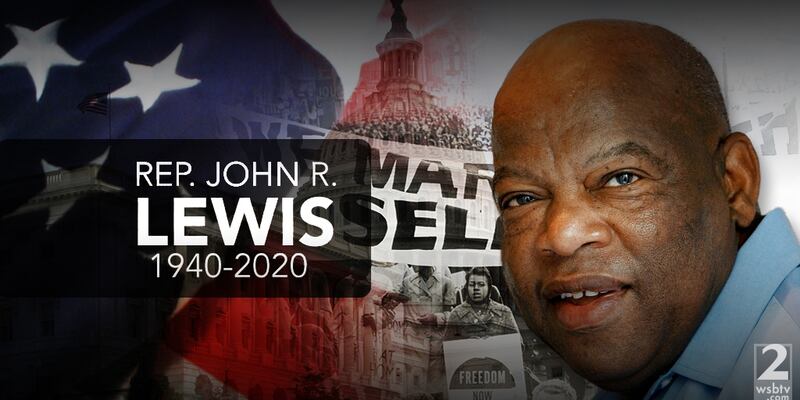ATLANTA — Georgia congressman and civil rights icon, John Lewis, has died. He was 80.
His family released a statement early Saturday morning, saying:
“It is with inconsolable grief and enduring sadness that we announce the passing of U.S. Rep. John Lewis. He was honored and respected as the conscience of the US Congress and an icon of American history, but we knew him as a loving father and brother. He was a stalwart champion in the on-going struggle to demand respect for the dignity and worth of every human being. He dedicated his entire life to non-violent activism and was an outspoken advocate in the struggle for equal justice in America. He will be deeply missed.”
LIVE coverage of how Lewis is being honored across the metro and the country, on Channel 2 Action News.
Since December 2019, Lewis had been battling Stage IV pancreatic cancer. Lewis said he learned about his cancer during a routine medical visit earlier that month.
In a statement about his diagnosis, Lewis vowed to continue serving the 5th Congressional District during his treatment.
“I have been in some kind of fight- for freedom, equality, basic human rights - for nearly my entire life. I have never faced a fight quite like the one I have now,” Lewis said. “I have decided to do what I know to do and do what I have always done: I am going to fight it and keep fighting for the Beloved Community. We still have many bridges to cross.”
[PHOTOS: John Lewis through the years]
From the halls of Congress to the streets of Atlanta, Lewis made his name known during the civil rights movement as he stood with Dr. Martin Luther King Jr. in their fight for justice in the face of segregation.
Lewis has represented Georgia’s 5th Congressional District since 1987.
Lewis was born the son of sharecroppers on Feb. 21, 1940. He and his siblings grew up working on the family's farm in Troy, Alabama.
Troy, like many other cities in the United States at the time, was divided by race.
“I would come home, ask my mother, ask my father, my grandparents, ‘Why?’ And they would say, ‘That’s the way it is. Don’t get in the way. Don’t get into trouble,’” Lewis said.
John Lewis changed our world in profound and immeasurable ways. @GAFirstLady, the girls, and I are praying for all of his loved ones, friends, and colleagues in this incredibly difficult time. (2/2)
— Governor Brian P. Kemp (@GovKemp) July 18, 2020
That division grew deeper in 1955 as the Montgomery bus boycott began.
Lewis became inspired by the movement and the man who emerged as its non-violent leader, Dr. Martin Luther King Jr.
"He lifted me; he inspired me," Lewis said about King. "I wrote a letter to Dr. Martin Luther King Jr. He wrote me back."
King sent Lewis a round-trip bus ticket to meet him in Montgomery.
“I saw Dr. King and Rev. Ralph Abernathy standing behind a desk in a little office, and Dr. King said, ‘Are you the boy from Troy? Are you John Lewis?’ I was so scared,” Lewis said. “And he started calling me the boy from Troy. And during that time, we became like brothers.”
[Remembering John Lewis: Friends, colleagues honor Georgia congressman]
They became brothers in a movement that was gaining momentum and would forever change the nation.
From the Freedom Riders who integrated bus terminals in the South to the segregated lunch counters in restaurants and stores, Lewis was part of a progressive movement that challenged the injustice of Jim Crow segregation in the south.
Not many of us get to live to see our own legacy play out in such a meaningful, remarkable way. John Lewis did:https://t.co/KbVfYt5CeQ
— Barack Obama (@BarackObama) July 18, 2020
That challenge led him to the nation's capital in 1963, where he was the youngest speaker at the march on Washington.
“How long can we be patient? We want our freedom and we want it now,” Lewis said from the steps of the Lincoln Memorial.
[READ: John Lewis honored as ‘warrior’ as he gets ready to start treatment for Stage IV cancer]
In 2014, Channel 2 Action News was with Lewis at the National Center for Civil and Human Rights, when he got his first glimpse of an exhibit highlighting his role in the march.
“We were trying to make a change. I don’t think we recognized or realized, I know I didn’t, that we were making history. We just wanted to make it possible for people to live with a sense of dignity,” Lewis said getting emotional as he walked through the center, reliving the historical moments.
Soon after the march on Washington, massive demonstrations began forming in the south. Blacks who were denied the right to vote were pushing for federal protection.
“Some people said we should march. Others said we should not. I took the position that we had been in Selma since 1962. We had been arrested in ’63 and ’64. People wanted to march. Then we should march,” Lewis said.
.@RepJohnLewis was a titan of the civil rights movement whose goodness, faith and bravery transformed our nation. Every day of his life was dedicated to bringing freedom and justice to all. pic.twitter.com/xMbfAUhLUv
— Nancy Pelosi (@SpeakerPelosi) July 18, 2020
They assembled in Selma, Alabama - just two-hours from Lewis’ hometown of Troy.
Despite the Alabama governor's ban on a march, Hosea Williams and a young Lewis led what was supposed to be a march to the state Capitol in Montgomery.
"Andy Young came, said a prayer. We stood up. We got off our knees and lined up in twos and started walking in an orderly fashion, with myself and Hosea leading the walk through the streets of Selma," Lewis said.
Their route took them over the Edmund Pettus Bridge. Waiting on the other side were state troopers and Sheriff Jim Clark.
"He wore a gun on one side, a nightstick on the other side. And he carried an electric cattle prodder in his hand," Lewis said. "He was vicious. He was an evil man."
[READ: Rep. John Lewis remembers Martin Luther King, Jr.]
The governor of Alabama had ordered police to stop the march.
“We get to the edge of the bridge, Hosea asked me, he said, ‘John, can you swim?’ I said, ‘No.’ I said, ‘What about you?’ He said a little. And I said something like, there’s too much water there and we’re not going to jump. We’re going forward,” Lewis said.
“It will be detrimental to your safety to continue this march,” Lewis said Clark told him. “I’m saying again, it’s unlawful assembly. You ought to disperse. You ought to disperse.
John Lewis was an American treasure.
— Martin Luther King III (@OfficialMLK3) July 18, 2020
He gave a voice to the voiceless, and he reminded each of us that the most powerful nonviolent tool is the vote.
Our hearts feel empty without our friend, but we find comfort knowing that he is free at last.
“The major said troopers advance. We saw these men putting on their gas masks. They came toward us, beating us with nightsticks. Trampling us with horses. Releasing the tear gas.
“I was hit in the head by state troopers with nightsticks. I still have the scar. I thought I was going to die on that bridge. I thought I saw death. I fell down, my legs went from under me.
"The blood on that bridge led to the cleansing of our country."
The violent moment became known as Bloody Sunday.
[READ: Bloody Sunday through the eyes of Rep. John Lewis]
Lewis recounted that painful memory to thousands of people who crowded the streets of Selma on March 7, 2015, to make the 50th anniversary of the 1965 Selma-to-Montgomery march.
“We were beaten, teargassed. Some of us left bloodied right here on this bridge,” Lewis said. “But you and I are here. We can bear witness to the distance we’ve come and the progress we’ve made in the past 50 years.”
On that anniversary, Lewis stood at the foot of the iconic Edmund Pettus Bridge -- the scene of one of America’s darkest moments.
The bridge was named for a former Confederate brigadier general, Democratic U.S. senator and grand dragon of the Alabama Ku Klux Klan.
And in another monumental moment, now as a U.S. Congressman, Lewis introduced the nation's first black president.
BREAKING: Bill and Hillary Clinton on the passing of civil rights icon Rep. John Lewis: "We have lost a giant." https://t.co/sbZWWqqpf7 pic.twitter.com/CteZkY4Je0
— ABC News (@ABC) July 18, 2020
“If someone had told me when we were crossing this bridge that one day I would be back here introducing the first African-American president, I would have said you’re crazy. You’re out of your mind. You don’t know what you’re talking about -- President Obama,” Lewis said.
"It is a rare honor in this life to follow one of your heroes and John Lewis is one of my heroes," President Barack Obama said during his address that morning.
[READ: Rep. John Lewis arrested at immigration rally in DC]
After the president's speech, Lewis led Obama, the first family, President George W. Bush and former first lady Laura Bush, across the Edmund Pettus Bridge.
The short walk paid tribute to the movement and reminded a new generation of the struggles of the past and the work that still needs to be done.
That struggle is chronicled within the walls of the National Center for Civil and Human Rights in downtown Atlanta.
During our tour with Lewis, one collection of paintings brought him to tears.
[READ: Messages of support pour in for Rep. John Lewis after cancer diagnosis]
The paintings featured Lewis as a child feeding chickens, listening to a speech from Dr. King and on the Edmund Pettus Bridge on Bloody Sunday.
“I want to be remembered as some bare-footed child, growing up in rural Alabama. Picking cotton. Gathering peanuts. Pulling corn. Preaching to chickens. Who just tried to help out to make things better,” Lewis said.
Elders, now ancestors. Hallelujah. pic.twitter.com/ze53PFMTuh
— Be A King (@BerniceKing) July 18, 2020
Lewis was first elected to the U.S. House in 1986, defeating Julian Bond in a bitter Democratic primary to become the second African-American to represent Georgia in Congress since Reconstruction.
Since then, Lewis has been re-elected 16 times without serious opposition in the heavily-Democratic district, often with huge margins of victory. He won another two-year term in 2018, facing no opposition.
[READ: John Lewis visits new Black Lives Matter mural with DC mayor]
One of the central figures that helped him transition into a career in politics, was his wife Lillian Miles Lewis. Many thought the couple was a perfect match.
“She was a feisty lady,” said Temi Silver, an event planner and longtime friend. “He was so sweet and gentle; he needed her to take care of his back. And she was the one to do it.”
It was after taking a job as a librarian at Atlanta University that she met her husband at a 1967 New Year’s Eve party at the home of Xernona Clayton, a television personality and civil rights activist. Clayton and another movement veteran, Dr. Bernard LaFayette, played matchmaker.
[STORY: Bloody Sunday through the eyes of Rep. John Lewis]
“I figured he needed a partner like Lillian, and Lillian needed someone who was moving into such important areas,” Clayton said. “She was a sober-minded, level-headed intellectual.”
She and John Lewis began a courtship, often double-dating with Julian and Alice Bond, movement friends who would become bitter rivals when Bond and Lewis opposed each other in a 1986 congressional race.
The Lewises were married in 1968.
Congressman Lewis would be a great and fitting example for the new national statue garden. He represents a part of American history we can all be proud of. Millions of African Americans lead better lives today because of John Lewis. All Americans have been touched by his courage.
— newtgingrich (@newtgingrich) July 18, 2020
Lillian Lewis continued to play a major behind-the-scenes role in her husband’s career, which progressed from winning a seat on the Atlanta City Council in 1981 to his upset victory over Bond in the 1986 congressional race.
While John forged his political career, his wife continued her career as an educator with an international perspective.
[READ: U.S. Navy to name ship after John Lewis]
She was associate director of the Institute for International Affairs and Development at Atlanta University from 1984 to 1989, a job that called on her to help develop a major in international studies, with an emphasis in Africa and the Caribbean. From 1989 to 2003, she was director of external affairs in the Office of Research and Sponsored Programs at Clark Atlanta University.
Lillian Lewis died in 2012 after being ill for an extended period of time.
John Lewis’ fighting spirit never left him throughout his time in the House. In 2016, following the mass shooting at the Pulse nightclub in Orlando, Lewis was one of 100 Democrats who staged a sit-in on the House floor, demanding then-Speaker Paul Ryan to keep the House in session to debate and vote on gun violence legislation that would expand background checks and preventing gun sales to suspected terrorists.
In August 2018, the city of Atlanta honored Lewis by renaming Freedom Parkway to the John Lewis Freedom Parkway. The adjoining park along the roadway was also renamed for Lewis.
“It’s very moving,” he told Channel 2′s Dave Huddleston at the time. “I want to thank (everyone) for believing in me and never, ever giving up on me.”
One of the fiercest critics of President Donald Trump, Lewis’ decision to boycott his inauguration in 2017 led the Republican to slam his Atlanta-based district as a “crime infested” area that’s in “horrible shape.”
Dubbed by allies as the “conscience of the House,” Lewis was a key supporter of the impeachment of Trump, delivering a fiery speech in September 2019 arguing that delaying the proceedings would “betray the foundation of our democracy.”
We are still waiting on funeral arrangements for Lewis.
Cox Media Group








